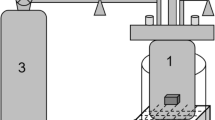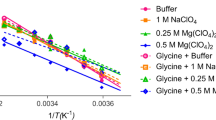Abstract
IN a previous study of the factors in ethanolic extracts of potato which influence the activity of potato phosphorylase, it was found that although the observed shortening of the amylose chains synthesized by this enzyme could, in part, be attributed to the presence of inorganic orthophosphate in the extracts, the latter did not cause an inhibition of phosphorylase as measured by the rate of liberation of phosphate from glucose-1-phosphate in the presence of starch primer1. However, demonstration of primer (activator) activity of such extracts after de-ionization with ion-exchange resin implied the presence of true inhibitory activity in the extracts. Presumably this inhibitory action is obscured by the presence of activator (primer). Since no inhibitory activity could be demonstrated in the acid or alkaline eluates from cation-exchange columns after chromatography of the potato extracts, it would appear that the inhibitor is acidic. However, attempts to recover inhibitory activity in acid eluates from anion-exchange chromatography of the extracts was complicated by the appearance in these eluates of trace amounts of material, derived from the columns, which in themselves possessed considerable inhibitory activity. In the case of weak phenolformaldehyde resins, the inhibition was traced to the inactivating effect of formaldehyde, whereas polystyrene-quaternary amine resins yielded a green non-fluorescent material devoid of nitrogen which also exhibited inhibitory activity. Pretreatment of the resins under a variety of conditions did not eliminate subsequent elution of inhibitory material.
This is a preview of subscription content, access via your institution
Access options
Subscribe to this journal
Receive 51 print issues and online access
$199.00 per year
only $3.90 per issue
Buy this article
- Purchase on Springer Link
- Instant access to full article PDF
Prices may be subject to local taxes which are calculated during checkout
Similar content being viewed by others
References
Schwimmer, S., and Weston, W. J., J. Biol. Chem., 220, 143 (1956).
Palmer, J. K., Connecticut Agric. Exp. Stat. Bull., 589 (Feb. 1955).
Johnson, G., and Schaal, L. A., Science, 115, 627 (1952).
Author information
Authors and Affiliations
Rights and permissions
About this article
Cite this article
SCHWIMMER, S. Phosphorylase Inhibitor in Potato: Separation from Activator and Possible Relation to Chlorogenic Acid. Nature 180, 149–150 (1957). https://doi.org/10.1038/180149a0
Issue Date:
DOI: https://doi.org/10.1038/180149a0
This article is cited by
-
Zusammenfassende �bersichtsberichte �ber Hydroxy-zimts�uren und ihre Bedeutung in Lebensmitteln
Zeitschrift f�r Lebensmittel-Untersuchung und -Forschung (1967)
-
Papierchromatographische Bestimmung der Ferula-, Kaffeeund Chlorogens�ure in pflanzlichen Lebensmitteln
Zeitschrift f�r Lebensmittel-Untersuchung und -Forschung (1966)
-
Phosphorylase inhibitor in the rind of tapioca tuber
Die Naturwissenschaften (1963)
-
Die Bedeutung der Chlorogensäure als Resistenzfaktor des Kartoffelschorfes
Der Züchter (1959)
Comments
By submitting a comment you agree to abide by our Terms and Community Guidelines. If you find something abusive or that does not comply with our terms or guidelines please flag it as inappropriate.



